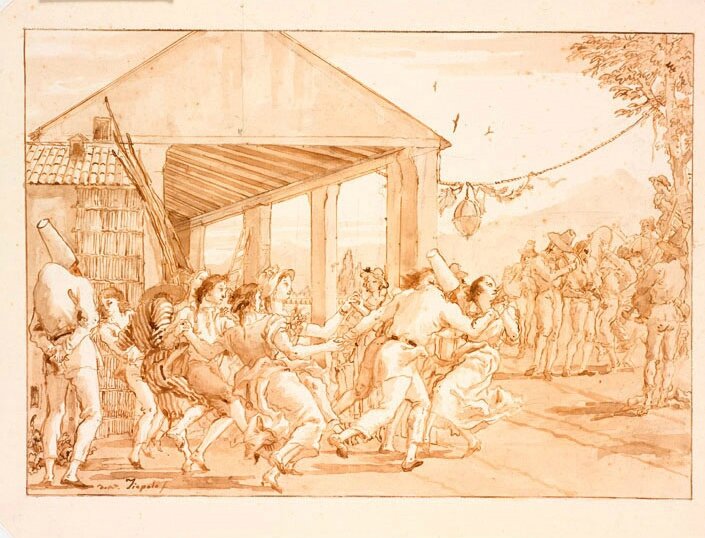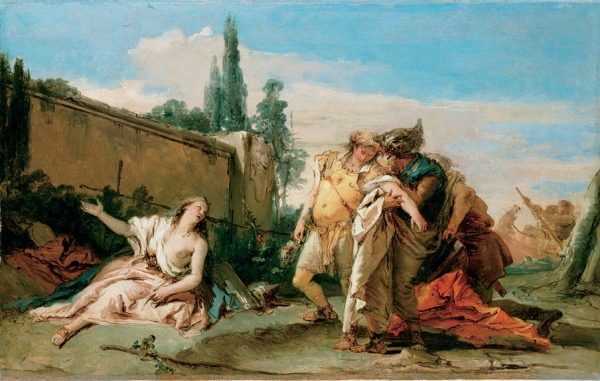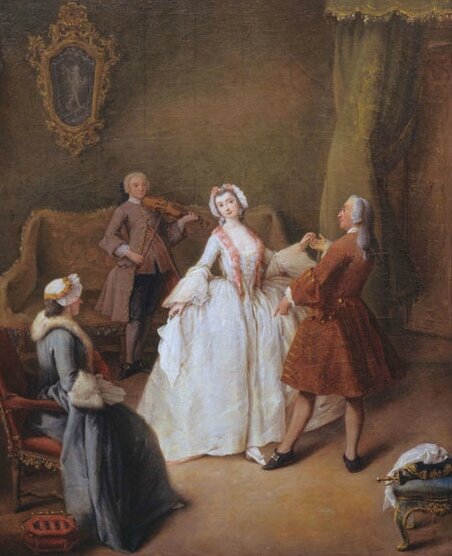"Venice: The Golden Age of Art and Music" opens at the Portland Art Museum
Giovanni Antonio Canal, called Canaletto, The Bucintoro at the Molo on Ascension Day, c. 1745, Oil on canvas. Philadelphia Museum of Art, The William L. Elkins Collection, Photo The Philadelphia Museum of Art / Art Resource, NY.
PORTLAND, ORE.- The Portland Art Museum is the only U.S. venue for Venice: The Golden Age of Art and Music opened on February 15. This stunning exhibition explores the heroic age of art and music in the Republic of Venice, also referred to as La Serenissima or “the most serene.”
Between the early 16th century and the fall of the Venetian Republic at the close of the 18th century, the great flourishing of the arts included innovative painters such as Tintoretto, Tiepolo, Canaletto, and Guardi, as well as composers Willaert, Gabrieli, Monteverdi, and Vivaldi who created some of the most beautiful music of the era. This spectacular international loan exhibition explores the important interrelationships of the visual arts and music in the city’s elaborate civic ceremonies, festivals, and culture.
The great artists working in Venice not only reveled in depicting the city’s processions, concerts, and dance, but many were accomplished musicians themselves. Composers depended on artists for set designs and costumes, and the dramatic stories of popular operas were embraced as subjects by painters and sculptors.
This multidisciplinary exhibition, organized by the Montreal Museum of Fine Arts, is the first to explore the interaction between the visual arts, music, and political culture in Venice and will include paintings, prints, drawings, illuminated manuscripts, and sculptures along with original period instruments and early music texts. Period music will be playing in the galleries enhancing the visitor’s experience.
The exhibition includes 108 objects from 48 lenders in Europe and North America. It is organized and installed in the following thematic sections:
Basilica of San Marco
The exhibition opens with an exploration of the Basilica of San Marco, which symbolized Venetian wealth, power, and piety. The church and the state were closely linked in Venice, with the Doge’s chapel at San Marco as the center of religious devotion. This section reflects the rich musical tradition of the cathedral.
Civic Pageantry
The Venetian Republic cultivated rituals as an important agent of statecraft. This section explores the splendid festivities and processions staged throughout the year, demonstrating the Republic’s grandeur, dignity, and piety to city inhabitants and visitors. Most notable was the drama of the Doge (chief magistrate) of Venice on the great state galley, the Bucintoro, being rowed out to wed the sea on Ascension Day. A vast flotilla of Venetians would accompany the Bucintoro. This event was a popular subject of painters including Canaletto.
The Scuole and The Ospedali
The exhibition presents the impact of the scuole (schools) and ospedali (hospital orphanages) on art and music in the city. These two types of charitable institutions made art and music integral to their primary missions to address religious and social needs.
Musicians and Concerts
This section looks at the impact and importance of music in Venice—from merchant class to patrician families. Ownership of musical instruments was considered essential to life. Venice was an important center for music publishers, and the city was famous for instrument makers producing instruments distinguished by extraordinary sound and beauty.
Popular Music
Popular music resounded through not only the opera theaters and taverns of Venice, but also the streets and waterways where gondoliers, street charlatans, and courtesans performed. The influence of commedia del l’arte and Carnival in providing music-filled activities in the city is explored in this section.
Mythology and Opera
Although born in Florence, opera flourished in Venice with resident composers and a host of opera venues. Music-loving tourists flocked to Venice from throughout Europe to see the latest works in the first successful commercial opera houses on the continent. Greek and Roman mythologies were popular subjects for both opera and paintings.
Giovanni Antonio Canal, called Canaletto, Interior of San Marcos, Venice, c. 1760, Oil on canvas, Montreal Museum of Fine Arts, Photo: Montreal Museum of Fine Arts, Brian Merrett.
Giovanni Antonio Canal, called Canaletto, Venice: The Feast Day of Saint Roch, c. 1735, Oil on canvas, National Gallery, London, Photo: © National Gallery, London/Art Resource, NY.
Francesco Guardi, Piazza San Marco with the Basilica and Campanile, c. 1775-85, Oil on canvas, Virginia Museum of Fine Arts, Richmond, Adolph D. and Wilkins C. Williams Fund, Photo: Katherine Wetzel, © Virginia Museum of Fine Arts.
Rosalba Carriera, Portrait of the singer Faustina Bordoni Hasse, 1730s, Pastel, Fondazione Musei Civici, Ca' Rezzonico, Venicei, Photo: Cameraphoto Arte, Venice/Art Resource, NY.
Giandomenico Tiepolo, Le menuet, 1756, Barcelone, Museu Nacional d’Art de Catalunya.
Giovanni Domenico Tiepolo, The Country Dance, c. 1797, Ink over chalk on paper, courtesy of the Museum of Art, Rhode Island School of Design, Providence, Photo: Erik Gould
Giovanni Battista Tiepolo, Rinaldo Abandons Armida, c. 1753, Oil on canvas, Gemӓldegalerie, Staatliche Museen, Berlin, Germany, Photo: Jörg P. Anders.
Giovanni Battista Tiepolo, "Apelles Painting the Portrait of Campaspe," ca. 1726, oil on canvas. The Montreal Museum of Fine Arts, Adaline Van Horne Bequest. Photo: Montreal Museum of Fine Arts.
Bernardo Strozzi, Street Musicians, 1634-37, Oil on canvas, Detroit Institute of Arts, Photo: The Bridgeman Art Library/
Giovanni Battista Piazzetta, The Singer, about 1730, Oil on canvas,, Musée Fabre, Montpellier, Photo: Frédéric Jaulmes © Musée Fabre de Montpellier Agglomération.
Anton Maria Zanetti, le Vieux (1680-1767). Gaetano Majorano, dit Caffarelli ou Caffariello, 1re moitié du XVIIIe s. Plume et encre brune sur traits à la mine de plomb, 28,6 x 20,6 cm. Venise, Fondazione Giorgio Cini. Inv. 36710.
Pietro Longhi, The Concert, 1741, Oil on canvas, Gallerie dell’Accademia, Florence, Italy, Photo: Cameraphoto Arte, Venice/Art Resource, NY.
Pietro Longhi, "The Dance Lesson," 1741, oil on canvas. Gallerie dell'Accademia, Florence, Italy. Photo: Cameraphoto Arte, Venice/Art Resource, NY.
Marietta Robusti, called la Tintoretta, Self-portrait with a Madrigale, c. 1580, Oil on canvas, Galleria degli Uffizi, Florence, Italy, Photo: Scala/Art Resource, NY.
Jacopo Comin, called Tintoretto, The Contest Between Appollo and Marsyas, c. 1545, Oil on canvas, Wadsworth Atheneum Museum of Art, Photo: Wadsworth Athemeum Museum of Art/Art Resource, NY..
Giovanni Busi, called Cariani, The Lute Player, c. 1515, Oil on canvas, Musée des Beaux-Arts, Strasbourg, Photo: M. Bertola.
Evaristo Baschenis, Still Life with Musical Instruments in an Interior, 1660s, Oil on canvas, Otto Naumann, Ltd., New York, Photo: Otto Naumann, Ltd., New York.
Matteo Sellas, Theorbo, 1630 or 1640, wood and ivory, Musèe de la musique, Paris, Photo: Jean-Marc Anglës.
Graduale di San Domenico di Castello, 1326-1330. Manuscrit, parchemin, 56 x 39 cm. Venise, Fondazione Musei Civici, Biblioteca del Museo Correr. Inv. Ms. Cl. V 131.

/https%3A%2F%2Fprofilepics.canalblog.com%2Fprofilepics%2F1%2F0%2F100183.jpg)
/https%3A%2F%2Fstorage.canalblog.com%2F03%2F02%2F119589%2F96711876_o.jpg)
/https%3A%2F%2Fstorage.canalblog.com%2F11%2F31%2F119589%2F94773502_o.jpg)
/https%3A%2F%2Fstorage.canalblog.com%2F20%2F83%2F119589%2F94772815_o.jpg)
/https%3A%2F%2Fstorage.canalblog.com%2F26%2F72%2F119589%2F75604929_o.jpg)
/https%3A%2F%2Fstorage.canalblog.com%2F59%2F60%2F119589%2F26458628_o.jpg)






















/http%3A%2F%2Fstorage.canalblog.com%2F19%2F23%2F119589%2F128179837_o.jpg)
/http%3A%2F%2Fstorage.canalblog.com%2F62%2F29%2F119589%2F126411628_o.jpg)
/http%3A%2F%2Fstorage.canalblog.com%2F15%2F87%2F119589%2F122308659_o.jpg)
/http%3A%2F%2Fstorage.canalblog.com%2F34%2F13%2F119589%2F120701661_o.jpg)